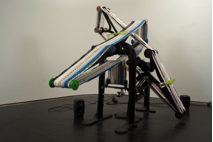![]()
NIME 2010 is hosted by the University of Technology Sydney [UTS]
Faculty of Design Architecture & Building [DAB]
Faculty of Arts & Social Sciences [FASS]
Faculty of Engineering & I.T. [FEIT]
Centre for Human Centred Technology Design



![]()


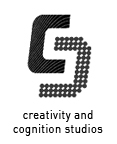
Program
Concert/Club Performances Program
N.B. This program is indicative but subject to change.
Accepted Submissions
Papers/Posters/Demos | Performances | Installations
Papers (Long/Short in proceedings with presentation)
Full Papers
- Andrew Schmeder and Adrian Freed. Support Vector Machine Learning for Gesture Signal Estimation with a Piezo-Resistive Fabric Touch Surface
- Yutaro Maruyama, Yoshinara Takegawa, Tsutomu Terada and Masahiko Tsukamoto. UnitInstrument: Configurable Musical Instruments
- Andrew McPherson and Youngmoo Kim. Augmenting the Acoustic Piano with Electromagnetic String Actuation and Continuous Key Position Sensing
- Rudolfo Quintas. GLITCH DELIGHTER: Lighter's Flame Base Hyper-Instrument for Glitch Music in Burning The Sound Performance
- Adnan Marquez-Borbon, Michael Gurevich and Paul Stapleton. Style and Constraint in Electronic Musical Instruments
- Alvaro CASSINELLI, Yusaku Kuribara, Alexis Zerroug, Masatoshi Ishikawa and Daito Manabe. scoreLight: playing with a human-sized laser pickup
- Owen Vallis, Jordan Hochenbaum and Ajay Kapur. A Shift Towards Open-Source Iterative Interface Design for Music
- Jan Schacher. Motion to Gesture To Sound: Mapping for Interactive Dance
- Chris Kiefer. A Malleable Interface for Sonic Exploration
- Charles Roberts, Matthew Wright, JoAnn Kuchera-Morin, Lance Putnam and Graham Wakefiled. Dynamic Interactivity Inside the AlloSphere
- Tilo Hähnel and Axel Berndt. Expressive Articulation for Synthetic Music Performances
- Sylvain Le Groux, Jonatas Manzolli, Paul FMJ, Verschure, Ulysses Bernardet, christoph guger, andre luvizotto, marti sanchez, Aleksander Valjamae and anna mura. The Brain Orchestra: Disembodied Interaction for Live Musical Performance
- Florian Alt, Alireza Sahami, Albrecht Schmidt, Stefan Legien and Julian Mennenöh. Creating Meaningful Melodies from Text Messages
- Jorge Solis, Klaus Petersen, Tetsuro Yamamoto, Masaki Takeuchi, Shimpei Ishikawa, Atsuo Takanishi and Kunimatsu Hashimoto. Development of the Waseda Saxophonist Robot and Implementation of an Auditory Feedback Control
- Noah Liebman, Michael Nagara, Jacek Spiewla and Erin Zolkosky. Cue-Bert: A New Mixing Board Concept for Musical Theatre
- Nobuyuki Umetani, Takeo Igarashi, Kenshi Takayama and Jun Mitani. Designing Custommade Metallophone with Concurrent Eigenanalysis
- Jieun Oh, Jorge Herrera, Nicholas J. Bryan, Luke Dahl and Ge Wang. Evolving the Mobile Phone Orchestra
- Enric Guaus, Tan Ozaslan, Eric Palacios and Josep Lluis Arcos. A gesture caption system for guitar left hand based on capacitive sensors
- Tobias Grosshauser, Ulf Großekathöfer and Thomas Hermann. New Sensors and Pattern Recognition Techniques for String Instruments
- Cesar Villavicencio. Developing a Hybrid Contrabass Recorder; Resistances, Expression, Gestures and Rhetoric
- Nick Collins. Contrary Motion: An oppositional interactive music system
- Joanne Cannon and Stuart Favilla. Expression and Spatial Motion: Playable Ambisonics
- Robin Fencott and Nick Bryan-Kinns. Hey Man, you're invading my Personal Space! Privacy and Awareness in Collaborative Music
- Johannes Mulder. The Loudspeaker as Musical Instrument
- Mark Havryliv. Composing For Improvisation with Chaotic Oscillators
- Georg Essl and Alexander Mueller. Designing Mobile Musical Instruments and Environments with urMus
- Sungkuk Chun, Andrew Hawryshkewich, Keechul Jung and Philippe Pasquier. Freepad: A Custom Paper-based MIDI Interface
- Etienne Deleflie and Greg Schiemer. Images as spatial sound maps
- Roger Mills. Dislocated Sound in Spontaneous Composition: A Survey of Improvisation in Networked Audio Platforms
- Karl Yerkes and Greg Shear. Disky: a DIY Rotational Interface with Inherent Dynamics
- Andrew Hawryshkewich, Philippe Pasquier and Arne Eigenfeldt. Beatback: A Real-time Interactive Percussion System for Rhythmic Practise and Exploration
- J. Anderson Mills III, Damien Di Fede and Nicolas Brix. Music Programming in Minim
- Victor Zappi, Andrea Brogni and Darwin Caldwell. OSC Virtual Controller
- Takashi Baba, Mitsuyo Hashida and Haruhiro Katayose. A Conducting System with heuristics of the conductor "VirtualPhilharmony"
- Atau Tanaka. Musical Affordance: Instruments, Mappings, and Mobiles
- Florent Berthaut, Myriam Desainte-Catherine and Martin Hachet. DRILE: an immersive environment for hierachical live-looping
- Smilen Dimitrov. Extending the soundcard for use with generic DC sensors - Demonstrated by revisiting a vintage ISA design
Short Papers
- Nicholas J. Bryan, Jorge Herrera, Jieun Oh and Ge Wang. MoMu: A Mobile Music Toolkit
- Luke Dahl and Ge Wang. Sound Bounce: Physical Metaphors in Designing Mobile Music Performance
- Alexander Refsum Jensenius, Kjell Tore Innervik and Ivar Frounberg. Evaluating the Subjective Effects of Microphone Placement on Glass Instruments
- Tomoyuki Yamaguchi, Tsukasa Kobayashi, Anna Ariga and Shuji Hashimoto. TwinkleBall: A Wireless Musical Interface for Embodied Sound Media
- Thor Magnusson. An Epistemic Dimension Space for Musical Devices
- Ajay Kapur and Michael Darling. Pedagogical Paradigm for Musical Robotics
- Madeleine Flynn and Tim Humphrey. epi-thet: a musical performance installation and a choreography of stillness
- Alfonso Perez. The Bowed Tube: a Virtual Violin
- Charles Martin, Benjamin Forster and Hanna Cormick. Cross-artform performance using networked interfaces: Last Man to Die's Vital LMTD
- Hongchan Choi and Ge Wang. LUSH: An Organic Eco-Musical System
- Andrew Brown. Network Jamming: Distributed Performance using Generative Music
- A. Baki Kocaballi, Petra Gemeinboeck and Robert Saunders. Investigating the potential for shared agency using enactive interfaces
- Ivar Frounberg, Kjell Tore Innervik and Alexander Refsum Jensenius. Glass instruments - From Pitch to Timbre
- Lonce Wyse and Duy Nguyen Dinh. Instrumentalizing Synthesis Models
- Ye Pan, Min-Gyu Kim and Kenji Suzuki. A Robot Musician Interacting with a Human Partner through Initiative Exchange
- Kristian Nymoen, Kyrre H. Glette, Ståle A. Skogstad, Alexander R. Jensenius and Jim Tørresen. Searching for cross-individual relationships between sound and movement features using an SVM classifier
- Kevin Schlei. Taming Multi-Point Data Streams Through Analysis: Relationship Based Implementations of Multi-Point Interfaces in Electronic Music Performance
- Ivica Bukvic, Tom Martin, Eric Standley and Michael Matthews. Introducing L2Ork: Linux Laptop Orchestra
- Miha Ciglar. tactile feedback based on acoustic pressure waves
- Amit Zoran and Robert Swartz. Digital Fabrication and The Design of The Musical Instrument
- Ted Hayes. Neurohedron: A Nonlinear Sequencer Interface
- Jordan Hochenbaum, Ajay Kapur and Matt Wright. Multimodal Musician Recognition: Toward a Modern Musical Classroom Through Use of HCI and Machine Learning
- Georg Essl, Michael Rohs and Sven Kratz. Use the Force (or something) - Pressure and Pressure-Like Input for Mobile Music Performance
- Ian Whalley. Generative Improv. & Interactive Music Project (GIIMP)
- Tilo Hähnel. From Mozart to MIDI: A Rule System for Expressive Articulation
Posters/Demos (Short paper in proceedings)
- Chikashi Miyama. Peacock: A non-haptic 3D performance interface (Demo)
- Alexander Müller, Fabian Hemmert, Götz Wintergerst and Ron Jagodzinski. Reflective Haptics: Resistive Force Feedback for Musical Performances with Stylus-Controlled Instruments (Demo)
- Aengus Martin, Sam Ferguson and Kirsty Beilharz. Mechanisms for Controlling Complex Sound Sources: Applications to Guitar Feedback Control (Poster)
- Kimberlee Headlee, Tatyana Koziupa and Diana Siwiak. Sonic Virtual Reality Game: How Does Your Body Sound? (Demo)
- Yoichi Nagashima. Untouchable Instrument "Peller-Min" (Poster)
- Brenda Hutchinson. Sound Initiated Drawing and Memory Impairment (Demo)
- Hyun-Soo Kim, Je-Han Yoon and Moon-Sik Jung. Interactive Music Studio : The Soloist (Demo)
- Alex Stahl and Patti Clemens. Auditory Masquing: Wearable Sound Systems for Diegetic Character Voices (Demo)
- A.Cavan Fyans, Michael Gurevich and Paul Stapleton. Examining the Spectator Experience (Poster)
- Jukka Holm, Harri Holm and Jarno Seppänen. Associating Emoticons with Musical Genres (Poster)
- Norma Saiph Savage, Norma Elva Chavez, Rodrigo Savage, Jose Emilio Garcia and Syed Reza Ali. Eyes Free Musical Mixer (Demo/Poster)
- Stuart Taylor and Jonathan Hook. FerroSynth: A Ferromagnetic Music Interface (Demo/Poster)
- Sihwa Park, Seunghun Kim, Samuel Lee and Woon Seung Yeo. ComPath: A Music-Making Environment with Interactive Map Interface (Demo/Poster)
- Christian Frisson, Stéphane Dupont, Xavier Siebert, Damien Tardieu, Thierry Dutoit and Benoit Macq. DeviceCycle: rapid and reusable prototyping of gestural interfaces, applied to audio browsing by similarity (Poster)
- Max Meier and Max Schranner. The Planets (Demo/Poster)
- Pierre Alexandre Tremblay and Diemo Schwarz. Surfing the Waves: Live Audio Mosaicing of an Electric Bass Performance as a Corpus Browsing Interface (Demo/Poster)
- Kris Kitani and Hideki Koike. ImprovGenerator:Online Grammatical Induction for On-the-Fly Improvisation Accompaniment (Demo/Poster)
- Teemu Ahmaniemi. Gesture Controlled Virtual Instrument with Dynamic Vibrotactile Feedback (Demo/Poster)
- Michael Berger. The GRIP MAESTRO: Idiomatic Mappings of Emotive Gestures for Control of Live Electroacoustic Music (Demo)
- Jim Torresen, Eirik Renton and Alexander Refsum Jensenius. Wireless Sensor Data Collection based on ZigBee Communication (Demo/Poster)
- Sam Ferguson, Emery Schubert and Catherine Stevens. Movement in a contemporary dance work and its relation to continuous emotional response (Poster)
- Mei-Ling Dubrau and Mark Havryliv. P[a]ra[pra]xis: towards genuine realtime 'audiopoetry' (Demo)
- Aristotelis Hadjakos and Max Mühlhäuser. Analysis of Piano Playing Movements Spanning Multiple Touches (Demo/Poster)
- Adrian Freed, John MacCallum, Andrew Schmeder and David Wessel. Visualizations and Interaction Strategies for Hybridization Interfaces (Demo/Poster)
- Greg Schiemer, Etienne Deleflie and Eva Cheng. Pocket Gamelan: using open source music software to evaluate processor bandwidth in a Linux phone (Demo/Poster)
- Laewoo Kang and Hsin-Yi Chien. Hé(?): Calligraphy as a Musical Interface (Demo/Poster)
- Javier Jaimovich and R. Benjamin Knapp. Synchronization of Multimodal Recordings for Musical Performance Research (Poster)
- James Murphy, Carl Burgin and Ajay Kapur. Studies of Membrane Potentiometers and Long Force Sensing Resistors for Musical Interfaces (Demo/Poster)
- Morteza Kasravi. Genertive improvising on Shur: One step beyond Radif (Demo/Poster)
- Robyn Taylor, Guy Schofield, John Shearer, Pierre Boulanger, Jayne Wallace and Patrick Olivier. humanaquarium: Designing for Participatory Performance (Demo/Poster)
- Rodolphe Koehly and Marcelo Wanderley. Development Kit for the fabrication of resistive based contact sensors using inexpensive, environmental-friendly and fully customisable raw materials (Demo/Poster)
- Lawrence Fyfe, Sean Lynch, Carmen Hull and Sheelagh Carpendale. SurfaceMusic: Mapping Virtual Touchbased Instruments to Physical Models (Demo/Poster)
- Nick Collins, Chris Kiefer, Zeeshan Patoli and Martin White. Musical Exoskeletons: Experiments with a Motion Capture Suit (Demo/Poster)
- Warren Burt. Packages for ArtWonk: New Mathematical Tools for Composers (Demo/Poster)
- Pieter Coussement, Benjamin Buch, Lueder Schmidt, Uwe Seifert, Jin Hyun Kim, Son-Hwa Chang and Jochen Arne Otto. "playing_robot": An Interactive Sound Installation in Human-Robot Interaction Design for New Media Art (Demo/Poster)
- Loïc Reboursière, Christian Frisson, Otso Lähdeoja, J. Anderson Mills III, Cécile Picard and Todor Todoroff. Multimodal Guitar: A Toolbox For Augmented Guitar Performances (Demo/Poster)
- Jeffrey Hass and Elizabeth Shea. Creating Integrated Music and Video for Dance: Lessons Learned and Lessons Ignored (Demo/Poster)
- Ståle A. Skogstad, Alexander Refsum Jensenius and Kristian Nymoen. Using IR Optical Marker Based Motion Capture for Exploring Musical Interaction (Demo/Poster)
- Jace Miller and Tracy Hammond. Wiiolin: a virtual instrument using the Wii remote (Demo)
- Martin Marier. The Sponge : a flexible interface (Poster)
- Felipe Otondo. A flexible sonic platform for music theatre performance (Demo/Poster)
- Wendy Suiter. Toward Algorithmic Composition of Expression in Music Using Fuzzy Logic (Demo/Poster)
- Sebastian Heinz. Conceptualizing a social musical TUI (Demo/Poster)
- Xiaoyang Feng. Irregular Incurve (Demo/Poster)
- Paul Rothman. The MK1 and MK2: Guitar-inspired, programmable MIDI performance controllers (Demo)
- Chih-Chieh Tsai, Teng-Wen Chang and Cha-Lin Charleen Liu. AN INTERACTION AMBIENCE PERFORMANCES PLATFORMS, AIDA (Demo/Poster)
- Ivica Bukvic and Ji-Sun Kim. PERCEPTION AND INTERPRETATION OF CONCURRENT AURAL SHAPES USING DREAM INTERFACE (Demo/Poster)
- Javier Jaimovich. Ground Me! An Interactive Sound Art Installation (Demo/Poster)
- Alison Mattek, Mark Freeman and Eric Humphrey. An Interactive, Computational Implementation of Cagean Composition Methodology (Demo/Poster)
- Kirsty Beilharz, Andrew Vande Moere, Barbara Stiel, Claudia Calo, Martin Tomitsch and Adrian Lombard. Expressive Wearable Sonification and Visualisation: Design and Evaluation of a Flexible Display (Demo/Poster)
- Garth Paine. Towards a Taxonomy of Realtime Interfaces for Electronic Music Performance (Demo/Poster)
- Birgit Gasteiger. Tangible User Interface Playing Virtual Acoustics (Demo/Poster)
- Nick Bryan-Kinns, Robin Fencott, Oussama Metatla, Shahin Nabavian and Jennifer Sheridan. Interactional Sound and Music: Listening to CSCW, Sonification, and Sound Art (Demo/Poster)
- Giuseppe Torre, Mark O'Leary and Brian Tuohy. POLLEN - A Multimedia Interactive Network Installation - (Poster)
- Justin hoffman. Panorama Architecture (Demo/Poster)
- Chris Geiger, Holger Reckter, Florian Schulz and Björn Wöldecke. Structured NIME Design - A Case Study with Generative Music on Multi-Touch Devices (Demo/Poster)
- Bert Bongers and Jos Mulder. Interaction Infrastructures for Expression (Demo/Poster)
- Christian Haines. Third Scream: a system for sound and musical experimentation using mobile phones (Demo/Poster)
- Jeremiah Nugroho and Kirsty Beilharz. Framework for Understanding and Evaluating User Centred Design in Wearable Expressions (Demo/Poster)
Demos ( No paper)
- So Kanno. Jamming Gear
- Damian Castaldi. Play 15 Broadway
- Barry Hill and Joshua Batty. Human Machine Music
- Jordan Hochenbaum, Owen Vallis, Dimitri Diakopoulos, Jim Murphy and Ajay Kapur. Bricktable Tangible and Multi-Touch Interface Installation
- Sungkuk Chun, Andrew Hawryshkewich, Keechul Jung and Philippe Pasquier. Freepad: A Custom Paper-based MIDI Interface
- Yoichi Nagashima. Controllable Untouchableness
- Christina Viola Oorebeek. E D G E S for solo percussion with amplified Plexiphone and electronics; Super 8 projector, oscillator or Super 8 projector audio samples
- Miha Ciglar and Nika Autor. Sonic beams / Acoustic shadows
- Tobias Großhauser. SensIT_II
- Peter Leonard. HOOLA
- Chikashi Miyama. Black Vox
- Gintas Kraptavicius. Live
- Donna Hewitt and Avril Huddy. Idol
- Alexander Schubert. Laplace Tiger
- Phillip Stearns. Aux Input
- Nick Collins. Kinesics
- Casper Schipper and Antal Ruhl. The String
- Robert Ratcliffe and Jon Weinel. Mutations
- Alain Renaud. Ping Pong'
- Miguel Ortiz. Carne
- Holland Hopson. Holland Hopson banjo+electronics
- Holland Hopson. Life on (Planet)
- Andrew Sorensen. Live coding improvisation
- Stephen Barrass and Diane Whitmer. Baroque Cello and EEG Continuo in D Minor
- Christopher Martinez, Randy Kemp, Lisa Tolentino, Robert Esler, Stjepan
- Rajko and Jessica Mumford. Radio Healer
- Andrew Brown. A Live Coding performance
- Somaya Langley. ID-i/o
- Chi-Hsia Lai and Charles Martin. Strike On Stage
- Stéphane Perrin and Utako Shibatsuji. The Ningen Dogs Orchestra
- Mark Havryliv. Improvisation for Chaotic Oscillator, Marimba and Saxaphone
- Christian Haines. [SOMETHING TO GO HERE] #4
- Jon Drummond. Jet Stream
- Garth Paine. Grace Space
- Mei-Ling Dubrau and Mark Havryliv. P[r]o[pri]et[a]ry in[ternet] [Ad]mo[ni]tion[s]
- Ryo Kanda. Tennendai no 0m0s
- Michael Schunior. "HAITIAN HAARPS"
- Thor Magnusson. ixi lang performance
- Eric Lyon and Ben Knapp. Stem Cells
- Ge Wang, Jieun Oh, Jorge Herrera, Nicholas J. Bryan and Luke Dahl.
- Stanford Mobile Phone Orchestra (MoPhO)
- Robert Mackay and Martin Daws. Altered Landscapes
- Sazdov and Torre. MOLITVA
- Georg Essl. Mobile Phone Orchestras presents...
- Christopher Hopkins. The Animus Winds
- Anthony Ptak. Live Bar-Coding
- Sonami. An Historical Moment on a line between A and B
- Kirsty Beilharz. Diamond Quills Hyper-Ensemble
- Stuart Favilla. Heretics Brew: Trajectories
- Andrew Johnston. Touching Dialogue
- Nicolas Collins. Salvage
- Sebastian Tomczak and Poppi Doser. Antia
- Bob Pritchard. What Does A Body Know?
Lucas Abela Vinyl Arcade
This work is showing at 35 Septimus Street Erskineville, opening 12 June 6-9pm, closing 19 June 6-9pm
Competition sessions take place twice a day, finals take place on closing night!
The vinyl rally is a large-scale interactive installation combining sound art, sculpture, video art, new media and competitive sports into every kid and kidult?s dream-hybrid; a kinetic, immersive, participatory play-set. The vinyl rally combines vinyl fetishism, video arcade mystique and the machismo of motor sports into a video game played within a real world setting! Imagine a racing track constructed from a mass of disused vinyl records, where remote control cars with styli attached to their chassis are raced by members of the crowd.
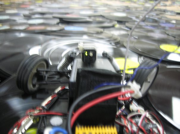
Warren Armstrong and Amanda Cole Twitterphonicon
The Twitterphonicon is an endless, self-generating musical piece created entirely from Twitter updates. A script, running continuously on a web server, searches for Twitter updates based on certain criteria, then converts the text into musical notes/chords and saves them to MIDI files. These files are then "played" in sequence by an application on a laptop. The audio is visually accompanied by a display of the tweets used to generate it. The sound design maps a different microtonal pitch to each letter of the alphabet. The constant feed of data from the Twitterphonicon is used to create indeterminate electronic music. The pitch mapping of each letter does not change, allowing the listener to hear and perhaps recognize reoccurring musical phrases made from particular words.
![]()
Conference foyer location installation
Stephen Barrass and Tim Barrass Flotsam, Jetsam and Lagan: Sonic Accelerometers for Water Sports
Flotsam, jetsam and lagan are inspired by the smooth pieces of driftwood found on the beaches of Murramarang National Park on the South Coast of NSW. These robust, waterproof, floatable objects wirelessly transmit a sonification of an internal 3 axis accelerometer that can be heard through FM headphones during sporting activities on the water. They can to be attached to an athlete?s arm, a paddle or to a skiff or kayak in order to listen to stroke, cadence, pace and many other aspects of performance. In exhibition they are displayed in a bowl of water with a light shining on them. Floating movements in the water cause them to produce small sounds that attract attention, pique interest and encourage passersby to pick them up. The irregular shape invites curious handling and the movements are heard from a loudspeaker situated inside the exhibition plinth out of sight. They are designed to be pleasing to the eye, hand and ear. Each prototype explores the functionality and aesthetics of different combinations of materials, technologies and sounds.
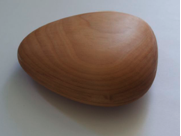
Somaya Langley The Suspect Backpack
The Suspect Backpack, a wearable mobile sonic media art experience provides the individual user with the opportunity for first-person interaction and engagement. Intended for use in public space, the public becomes an unwitting audience, meanwhile creating a personalised and intimate environment for the individual. Immersive in its very nature, sound is employed to convey feelings of anxiety spoken by a ?monkey mind?, while using news report announcements to inform the public of suspicious individuals. Intentional inevitable proximal shifts between audience and individual, and the readjustment of personal space affect sonic output.
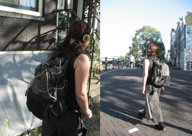
Kathrin Stumreich Fabric machine
Two fabric loops, driven by a motor, create a division in space. Light sensors measure the opacity of the textile; there are thousands of different fabric samples out there, old ones , with ancient weaving tecniques, different embroidery, prints, etc. Algorithms/ electro acoustic sound generation: Each different fabric sample is able to deliver a highly individual sound source. The pure analogue translation from a electric signal (generated by the algorithm of the weaving tecnique) gives you an incredible range of different sound qualities, you have to learn to play this instrument, like learning how to play a guitar.The way all pieces are sewed together for a fabric sound track is responsible for beats, breaks and rhythms. Interface: Sowing interfaces out of different pieces of clothes like men shirt, underwear and many more, makes your individual clothing hearable. Without any special effects, the pure fabric is used as sound source.
